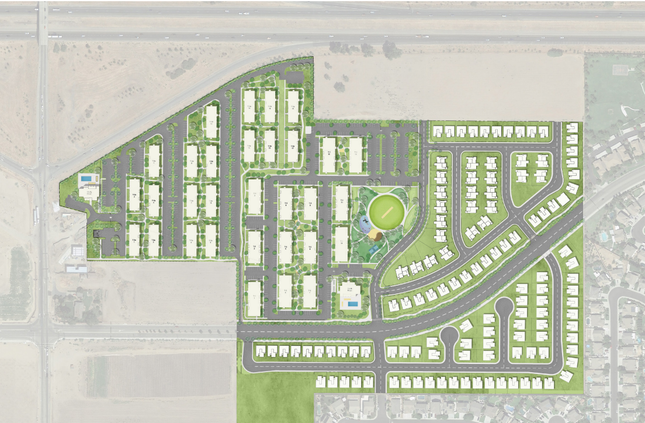Part of the land where 818 homes are being proposed on the southeast corner of Main Street and 120 Bypass was ground zero for one of the three nastiest political battles in Manteca during the 1980s.
The site was where Yellow Freight wanted to build a major truck terminal.
When a split council said no and Yellow Freight refused an alternative site on the northwest corner of Airport Way and the 120 Bypass where the Stadium Retail Center anchored by Kohl’s is located today, the national trucking company that went belly-up last year located in Tracy instead.
That was in 1989.
Today, Quaterra plans to build 672 apartments, 48 duplex units and 98 single family homes on 59 acres on the southeast corner of the 120 Bypass and Main Street interchange.
Quarterra is conducting a virtual community meeting on the proposed project on Monday, Sept. 30, from 5:30 to 6:30 p.m.
You can join in via Zoom (https://tinyurl.com/QuintalRoad2) or by phone (669-900-9128) and enter meeting ID 8i6 2512 5450#
The meeting will consist of a short presentation on the project and address community benefits.
There will be time for community feedback when questions about the project will be answered.
The meeting will be recorded and made available upon request to those who cannot attend.
For more information, contact Terry Craig at 510-334-4866.
The Yellow Freight outcome made
residential feasible south of the Bypass
It was a different Manteca back in 1989.
Manteca had just under 41,000 residents as opposed to 92,000 today.
The first tract home wouldn’t be built south of the 120 Bypass for another 10 years.
The community generally embraced truck traffic as it was equated to jobs given Manteca — between commuters and those working locally — was overwhelmingly blue collar.
Today more than a few people are hammering elected leaders because they blame them for allowing more trucks in Manteca.
There are many lessons from the Yellow Freight controversy that are worth repeating.
The Yellow Freight battle nearly touched off Manteca’s second civil war.
Less than seven years earlier the community was torn apart during a recall of then Mayor Trena Kelley and council members Rick Wentworth and Bobby Davis over the council’s termination of a popular police chief.
Ultimately it came out that they were more than justified for their decision. That however didn’t matter. The bad blood the recall created poisoned Manteca politics well into the late 1990s.
That is lesson No. 1: Recalls are extremely dangerous weapons to unleash.
Toying with the idea is one thing. Pulling the trigger to make a vote happen even if the status quo is maintained virtually always does far more harm than good.
The issue for the council majority that rejected Yellow Freight in 1989 was simple. The believed having a major truck terminal right off the 120 Bypass on Main Street was extremely bad planning.
Those who backed the proposed freight terminal just saw the well-paying jobs in a town that was becoming more and more of a commuter bedroom community with each passing year.
The council majority thought it was a lousy development decision and even worse planning.
This was a full decade before the first subdivision was built south of the 120 Bypass.
It was also when a young Manteca city planner was quoted by the Modesto Bee as saying Manteca would never develop south of the 120 Bypass because the freeway was an insurmountable barrier.
Imagine how much different that area would be today even if homes had still been built south of the 120 Bypass along with Yellow Freight.
Truck traffic would have merged
on Bypass in middle of 99 backup
There would have been constant truck movements intermingled with traffic on Main Street between the 120 Bypass and Woodward Avenue.
Worse yet, there would have been significant truck traffic merging onto the eastbound 120 Bypass right where the deadly weave starts as the freeway nears the Highway 99 interchange.
While hindsight is 20-20, the council majority that killed Yellow Freight at that location tried to steer the firm to a parcel on Airport Way where the Stadium Retail Center stands today.
If that had happened the odds are what has since unfolded in the area in terms of development would have been much different. A major freight terminal would have encouraged related development and not a major retail center.
As such the city would likely never have snared Great Wolf or even placed Big League Dreams there on property that was once attached to the municipal wastewater treatment plant.
That is lesson No. 2: Planning decisions made in the here and now without much thought to the future can have negative consequences.
That said even if the council majority got the long range call right on nixing the Main Street site for Yellow Freight they would have blown it if the trucking firm accepted the alternative site instead of opting to locate instead in Tracy.
The council decision also had the side effect of getting Manteca labeled as being anti-business.
Whether that was deserved or not, it was abundantly clear then as well as through much of the 1990s when Tracy was getting the lion’s share of new business park employers that Manteca was doing little in terms of physically having ground ready for employment centers to build other than coloring in the appropriate zoning on maps.
That is lesson No. 3: Cities that want job growth must do more than just talk a good game.
At the same time a high profile scenario that goes wrong can end up bruising a community’s reputation as a place it is worth taking the risk and investing in to grow a company while at the same time creating jobs.
Ironic as it may sound, some of the opposition to Yellow Freight was that they didn’t provide “the right” jobs.
This is when the fantasy started that the Northern San Joaquin Valley would be the logical place for the Silicon Valley to establish satellite operations. The year 1989 was about the same time municipal bureaucrats and elected leaders started chasing unicorns in the form of “high paying, high tech jobs.”
Manteca right around that time did land a “high tech” employer in the form of Indy Electronics.
It rapidly became the city’s largest private sector employee boasting 700 workers at one point.
But most of the jobs were barely above minimum wage as it was essentially an assembly line operation. Those jobs disappeared when Indy moved them to Mexico and then Asia where labor was much cheaper.
Alphatec and Turnkey Solutions followed Indy in quick succession but they too moved their jobs to Mexico and/or Asia. Making things even more ironic, the workforce for the companies were comprised primarily of Stockton residents who commuted to Manteca.
Truck jobs can be
head of household jobs
Lesson No. 4 is fairly basic: You can’t simply land specific jobs in a community that everyone lusts over as it takes a whole repertoire of conditions beyond mere desire to secure them.
After Yellow Freight had been up and running in Tracy for five years, the Bulletin did a story on the makeup of the firm’s workforce.
They confirmed lion’s share — just over 30 percent — lived in Manteca. Whether they moved to Manteca after Yellow Freight relocated its terminal out of the Bay Area or lived here before they were hired, the largest number of their employees are not from Tracy.
Lesson No. 5: Landing an employer doesn’t assure they will even hire a majority of their workforce from local residents.
As ironic as it may seem, Manteca — as well as Stockton — in workforce surveys conducted over the years are constantly the No. 1 or No. 2 hometown for those fulfilling industrial, business park or distribution center jobs in Lathrop.
The trucking jobs that some looked down on back in 1989 now often pay more than the jobs you need the benefit of a college degree to land.
There are a number of trucking jobs paying $70,000 plus a year to start where you return home every night that go begging.
And while there’s the issue of having to pass a drug test to be hired and periodically thereafter to maintain employment, it’s tough to find a that pays that well that you don’t have to go into debt for 30 years simply to be able to apply for it.
Lesson No. 6: Many truck driving jobs are huge well-paying and certainly pay more than the vast majority of jobs provided in distribution centers offered by the likes of Amazon and others.
As for the other nasty political battle of the 1980s, sandwiched between the recall and Yellow Freight was the push to limit growth.
Manteca adopted the Central Valley’s first growth management program in 1989.
There was a fight over whether it should be 1.7 percent — what a community-based group wanted or a more liberal 5.5 percent that developers wanted.
The council ultimately settled on 3.9 percent to head off a dueling referendum from reaching the ballot.
Manteca growth in 1985, by the way, still stands as a record — 12.1 percent.
To contact Dennis Wyatt, email dwyatt@mantecabulletin.com






